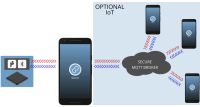GUI for ATMEL, PIC, STM, NXP, ESP32, ESP8266, ARDUINO and others

Presentation of the ANDROID application GUI-O "IoT Device Browser", which is intended for programmers of any microcontrollers such as ATMEL, PIC, STM, NXP, ESP32, ESP8266, ARDUINO and others. GUI-O is a finished application and is an interpreter of ASCII strings command from the microcontroller. The initial demo version of GUI-O allows for the use of up to 6 graphical elements for free. With a touch of creativity, it's possible to use multiple screens, each with up to 6 elements, at no cost.
Under the acronym GUI-O there is a tool that could be called "IoT Device Browser".
GUI-O is a complete ANDROID application, while GUI-specific code is written on the microcontroller. The application acts as an interpreter, similar to a web browser, but in this case your microcontroller is the server. GUI-O listens and executes the device commands in real time. GUI-O works locally and also over the Internet. You can use the same application to access any device that supports the GUI-O ASCII protocol, similar to accessing web pages with the same web browser.
Our solution is based on industry practices for the development of complex devices. Using GUI-O, devices are developed faster and with higher quality, as the same developer designs the device functionality and the GUI for management in parallel, reducing development and maintenance costs.
The current standard practice requires the use of multiple technologies and development environments, which increases time delays and can lead to lower quality. The article below presents this concept in more detail.
The application is developed using Qt (cross-platform application development framework in C++), which allows the most complex GUIs to run smoothly with modern graphical elements.
Two articles are attached. The first one presents in detail the theory of the GUI-O ASCII protocol and the basics of its use, while the second article focuses on the integration of local and remote GUIs for IoT. The special feature of this solution is that the ANDROID application for the local GUI also allows communication with the remote GUI.



Discussion (0 commentaire(s))